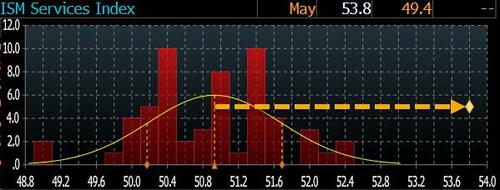Services ISM Unexpectedly Surges Out Of Contraction, Prints At 53.8, Above All Estimates
After the Manufacturing ISM unexpectedly tumbled to the lowest level since February (led by a collapse in New Orders which tumbled at the fastest rate since Dec 2023), markets were expecting today’s Services ISM to come in well below estimates and to be generally ugly. And, as always happens, when Wall Street expects something, the opposite happens and moments ago the Institute for Supply Management reported that the May ISM Services index unexpectedly jumped from a contractionary print of 49.4 in April to a 53.8 in May, which was not only the highest print since August 2023…
… but was also above the highest Wall Street estimate of 52.5 (from Dai-Ichi) and was a 4-sigma beat to the median estimate of 51.0.
What is perhaps more important is that unlike the Manucaturing ISM print which saw New Orders collapse to 45.4 and prompted rumbling of a recession, the ISM Service New Orders actually jumped to 54.1, from 52.2, pushing the spread between the two New Orders series to 8.7, the widest since last October.
Also of note, the closely watched Employment and Prices Paid indexes also moved in the right direction: Prices Paid dipped from 59.2 to 58.1, below the 59.0 expected (meaning less latent inflation),and further away from stagflationary territory while Employment remained contractionary but rebounded from last month’s 45.9 print to 47.1 (if just below the 47.2 exp).
Here is the full breakdown:
Commenting on the report, Anthony Nieves, Chair of the ISM, said the following: “In May, the Services PMI registered 53.8 percent, 4.4 percentage points higher than April’s reading of 49.4 percent. The contraction in April ended a string of 15 months of services sector growth following a composite index reading of 49 percent in December 2022; the last contraction before that was in May 2020 (45.4 percent). The Business Activity Index registered 61.2 percent in May, which is 10.3 percentage points higher than the 50.9 percent recorded in April. The New Orders Index expanded in May for the 17th consecutive month after contracting in December 2022 for the first time since May 2020; the figure of 54.1 percent is 1.9 percentage points higher than the April reading of 52.2 percent. The Employment Index contracted for the fifth time in six months, though at a slower rate in May with a reading of 47.1 percent, a 1.2-percentage point increase compared to the 45.9 percent recorded in April.
“The Supplier Deliveries Index registered 52.7 percent, 4.2 percentage points higher than the 48.5 percent recorded in April. The index went into expansion territory — indicating slower supplier delivery performance — in May for the first time since January.”
Nieves concluded “The increase in the composite index in May is a result of notably higher business activity, faster new orders growth, slower supplier deliveries and despite the continued contraction in employment. Survey respondents indicated that overall business is increasing, with growth rates continuing to vary by company and industry. Employment challenges remain, primarily attributed to difficulties in backfilling positions and controlling labor expenses. The majority of respondents indicate that inflation and the current interest rates are an impediment to improving business conditions.”
While not nearly as candid and open as the Dallas Fed Survey respondents, comments from ISM respondents were not as promising as the data suggests. People are worrying about tariffs, high interest rates and the upcoming US election.
- “The last month has brought a level of stability not seen is some time. Recent news of the Biden administration’s tariff actions is of high concern on disruption, with little information on the exclusion process when it comes to which materials and products will actually be impacted.” [Accommodation & Food Services]
- “Higher interest rates are reducing capital investment and slowing down major facility upgrades.” [Agriculture, Forestry, Fishing & Hunting]
- “Residential construction continues to struggle, with high mortgage rates on the for-sale side. Higher interest rates are driving up the cost of capital and making ‘build to rent’ projects harder to pencil. Building season is getting into full swing, but higher lumber prices — especially oriented strand board (OSB) panels — have pinched margins.” [Construction]
- “Some items continue to be hard to keep at proper levels in inventory: syringes, sterile water and normal saline. Some paper towels for dispensers are even being back-ordered.” [Health Care & Social Assistance]
- “Companies in most industries continue to be deliberate with employee and nonemployee labor hiring decisions. Concerns about the upcoming election loom large, as well as uncertainty around the current economic climate, particularly inflation.” [Management of Companies & Support Services]
- “General uncertainty regarding the U.S. Federal Reserve’s position on future interest rates and the current political environment is affecting consumer sentiment.” [Professional, Scientific & Technical Services]
- “Continuing apprehension regarding construction contractors’ capacity and increasing price of projects. Often, bid prices are exceeding engineer and budget estimates.” [Public Administration]
- “Slowdown in economy being felt.” [Retail Trade]
- “In general, business has been steady. Hiring is slowing and prices are slightly climbing.” [Transportation & Warehousing]
- “We are making adjustments to our employment level, capital investing strategies, and managing borrowed debt to achieve our 2024 financial goals.” [Utilities]
- “High food costs having an impact on customer demand and resulting in flat business overall. Business activity stable. Supplier costs continue to soften.” [Wholesale Trade]
In kneejerk response, US 2y yield is rising slightly 1bp after the data (I would expect a bigger move), EURUSD is down about 0.1%, while the USDJPY surged to 156.40, with the yen dropping as much as 1% against the dollar as the market is once again whiplashed in its rate cut expectations.
Tyler Durden
Wed, 06/05/2024 – 10:24





